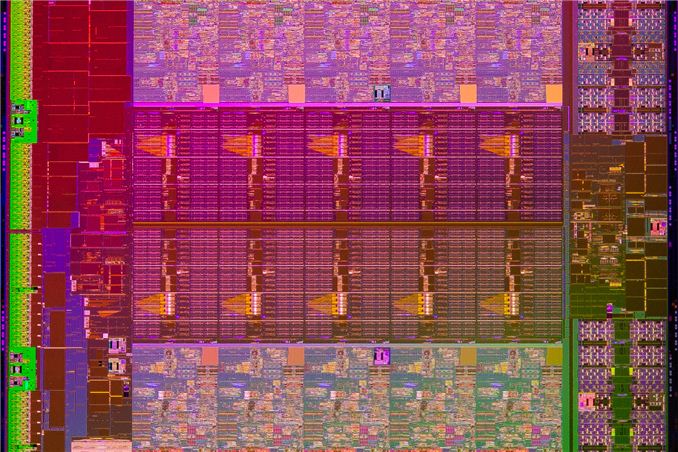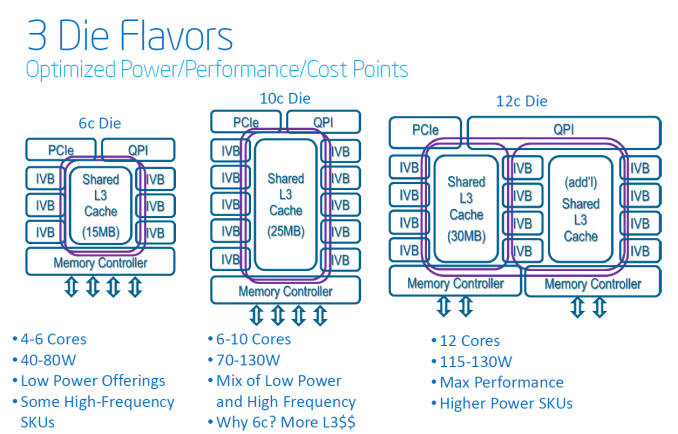Intel's Xeon E5-2600 V2: 12-core Ivy Bridge EP for Servers
by Johan De Gelas on September 17, 2013 12:00 AM EST
The core architecture inside the latest Xeon is typically a step behind what you find inside the latest desktop and notebook chips. A longer and more thorough validation is one reason, but there is more. The high-end model of the Xeon E5-2600 V2 or "Ivy Bridge EP" is, aside from the core architecture, completely different from the Ivy-bridge "i7 \-3xxx" that was launched in the spring of last year. With up to twelve cores, two integrated memory controllers, no GPU and 30MB L3 cache, it is the big brother of the recently reviewed Ivy-bridge E (Core i7-4960X). Intel has three die flavors of the Ivy-bridge EP:
The first one is the one with the lowest core count (4/6 cores), which is found in SKUs targeted at the workstation and enthusiast market (high frequencies) or low power SKUs; this is the core being used in the enthusiast Ivy Bridge-E processors. The second one is targeted at the typical server environment with higher core counts (6 to 10 cores) and a larger L3 cache (25MB). The third and last one is the high performance HPC and server die, with 12 cores, two memory controllers for lower memory latency, and 30MB of L3 cache.
The cool thing about the newest Xeon E5 processors is that they run on the same Romley EP platform as LGA-2011 chips. This should save the OEMs a lot of time and money, and hopefully these savings will trickled down to the customers. Let's see how Intel's latest server update performs, and if it manages to impress more than the enthusiast Ivy Bridge-E.











70 Comments
View All Comments
JohanAnandtech - Friday, September 20, 2013 - link
I have to admit were are new to SPECjbb 2013. Any suggestions for the JVM tunings to reduce the GC latency?mking21 - Wednesday, September 18, 2013 - link
Surely its more interesting to see if the 12 core is faster than the 10 and 8 core V2s.Its not obvious to me that the 12 Core can out perform the 2687w v2 in real world measures rather than in synthetic benchmarks. The higher sustained turbo clock is really going to be hard to beat.
JohanAnandtech - Wednesday, September 18, 2013 - link
There will be a follow-up, with more energy measurements, and this looks like a very interesting angle too. However, do know that the maximum Turbo does not happen a lot. In case of the 2697v2, we mostly saw 3 GHz, hardly anything more.mking21 - Wednesday, September 18, 2013 - link
Yes based on bin specs 3Ghz is what I would expect from 2697v2 if more than 6 or more cores are in use. 5 or more cores on 2687wv2 will run @ 3.6Ghz. While 2690v2 will run 3.3Ghz with 4 or more cores. So flat out the 12 core will be faster than 10 core will be faster than 8 core - but in reality hard to run these flat out with real-world tasks, so usually faster clock wins. Look forward to u sharing some comparative benchmarks.psyq321 - Thursday, September 19, 2013 - link
3 GHz is the maximum all-core turbo for 2697 v2.You are probably seeing 3 GHz because several cores are in use and 100% utilized.
JohanAnandtech - Friday, September 20, 2013 - link
With one thread, the CPU ran at 3.4 GHz but only for very brief periods (almost unnoticeable).polyzp - Saturday, September 21, 2013 - link
AMD's Kaveri IGPU absolutley destroys intel iris 5200! Look at the first benchmarks ever leaked! +500% :OAMDFX .blogspot.com
Jajo - Tuesday, October 1, 2013 - link
E5-2697v2 vs. E5-2690 +30% performance @ +50% cores? I am a bit disappointed. Don't get me wrong, I am aware of the 200 Mhz difference and the overall performance per watt ratio is great but I noticed something similar with the last generation (X5690 vs. E5-2690).There are still some single threaded applications out there and yes, there is a turbo. But it won't be aggressive on an averagely loaded ESXi server which might host VMs with single threaded applications.
I somehow do not like this development, my guess is that the Hex- or Octacore CPUs with higher clocks are still a better choice for virtualization in such a scenario.
Just my 2 cents
Chrisrodinis - Wednesday, October 23, 2013 - link
Here is an easy to understand, hands on video explaining how to upgrade your server by installing an Intel E5 2600 V2 processor: http://www.youtube.com/watch?v=duzrULLtonMDileepB - Thursday, October 31, 2013 - link
I think 12 core diagram and description are incorrect! The mainstream die is indeed a 10 core die with 25 MB L3 that most skus are derived from. But the second die is actually a 15 core die with 37.5 MB. I am guessing (I know I am right :-))That they put half of the 10 core section with its QPIs and memory controllers, 5 cores and 12.5 MB L3 on top and connected the 2 sections using an internal QPI. From the outside it looks like a 15 core part, currently sold as a 12 core part only. A full 15 core sku would require too much power well above the 130W TDP that current platforms are designed for. They might sell the 15 core part to high end HPC customers like Cray! The 12 core sku should have roughly 50% higher die area than the 10 core die!